 BY TENNESSEE WILLIAMS PLAYS Baby Doll & Tiger Tail Camino Real Candles to the Sun Cat on a Hot Tin Roof Clothes for a Summer Hotel Fugitive Kind The Glass Menagerie A House Not Meant to Stand A Lovely Sunday for Creve Coeur Mister Paradise and Other One Act Plays Not About Nightingales The Notebook of Trigorin Something Cloudy, Something Clear Spring Storm Stairs to the Roof Stopped Rocking and Other Screen Plays A Streetcar Named Desire Sweet Bird of Youth 27 Wagons Full of Cotton and Other Plays The Traveling Companion and Other Plays The Two-Character Play Vieux Carr THE THEATRE OF TENNESSEE WILLIAMS, VOLUME I Battle of Angels, A Streetcar Named Desire, The Glass Menagerie THE THEATRE OF TENNESSEE WILLIAMS, VOLUME II The Eccentricities of a Nightingale, Summer and Smoke, The Rose Tattoo, Camino Real THE THEATRE OF TENNESSEE WILLIAMS, VOLUME III Cat on a Hot Tin Roof, Orpheus Descending, Suddenly Last Summer THE THEATRE OF TENNESSEE WILLIAMS, VOLUME IV Sweet Bird of Youth, Period of Adjustment, The Night of the Iguana THE THEATRE OF TENNESSEE WILLIAMS, VOLUME V The Milk Train Doesnt Stop Here Anymore, Kingdom of Earth (The Seven Descents of Myrtle), Small Craft Warnings, The Two-Character Play THE THEATRE OF TENNESSEE WILLIAMS, VOLUME VI 27 Wagons Full of Cotton and Other Short Plays THE THEATRE OF TENNESSEE WILLIAMS, VOLUME VII In the Bar of a Tokyo Hotel and Other Plays THE THEATRE OF TENNESSEE WILLIAMS, VOLUME VIII Vieux Carr, A Lovely Sunday for Creve Coeur, Clothes for a Summer Hotel, The Red Devil Battery Sign POETRY Collected Poems In the Winter of Cities PROSE Collected Stories Hard Candy and Other Stories One Arm and Other Stories Memoirs The Roman Spring of Mrs. Stone The Selected Letters of Tennessee Williams, Volume I The Selected Letters of Tennessee Williams, Volume II Where I Live: Selected Essays TENNESSEE WILLIAMS A STREETCAR NAMED DESIRE INTRODUCTION BY ARTHUR MILLER
BY TENNESSEE WILLIAMS PLAYS Baby Doll & Tiger Tail Camino Real Candles to the Sun Cat on a Hot Tin Roof Clothes for a Summer Hotel Fugitive Kind The Glass Menagerie A House Not Meant to Stand A Lovely Sunday for Creve Coeur Mister Paradise and Other One Act Plays Not About Nightingales The Notebook of Trigorin Something Cloudy, Something Clear Spring Storm Stairs to the Roof Stopped Rocking and Other Screen Plays A Streetcar Named Desire Sweet Bird of Youth 27 Wagons Full of Cotton and Other Plays The Traveling Companion and Other Plays The Two-Character Play Vieux Carr THE THEATRE OF TENNESSEE WILLIAMS, VOLUME I Battle of Angels, A Streetcar Named Desire, The Glass Menagerie THE THEATRE OF TENNESSEE WILLIAMS, VOLUME II The Eccentricities of a Nightingale, Summer and Smoke, The Rose Tattoo, Camino Real THE THEATRE OF TENNESSEE WILLIAMS, VOLUME III Cat on a Hot Tin Roof, Orpheus Descending, Suddenly Last Summer THE THEATRE OF TENNESSEE WILLIAMS, VOLUME IV Sweet Bird of Youth, Period of Adjustment, The Night of the Iguana THE THEATRE OF TENNESSEE WILLIAMS, VOLUME V The Milk Train Doesnt Stop Here Anymore, Kingdom of Earth (The Seven Descents of Myrtle), Small Craft Warnings, The Two-Character Play THE THEATRE OF TENNESSEE WILLIAMS, VOLUME VI 27 Wagons Full of Cotton and Other Short Plays THE THEATRE OF TENNESSEE WILLIAMS, VOLUME VII In the Bar of a Tokyo Hotel and Other Plays THE THEATRE OF TENNESSEE WILLIAMS, VOLUME VIII Vieux Carr, A Lovely Sunday for Creve Coeur, Clothes for a Summer Hotel, The Red Devil Battery Sign POETRY Collected Poems In the Winter of Cities PROSE Collected Stories Hard Candy and Other Stories One Arm and Other Stories Memoirs The Roman Spring of Mrs. Stone The Selected Letters of Tennessee Williams, Volume I The Selected Letters of Tennessee Williams, Volume II Where I Live: Selected Essays TENNESSEE WILLIAMS A STREETCAR NAMED DESIRE INTRODUCTION BY ARTHUR MILLER  A NEW DIRECTIONS BOOK Copyright 1947 by The University of the South Renewed 1957 by The University of the South Introduction, Regarding Streetcar Copyright 2004 by Arthur Miller The World I Live In Copyright 1957 by The University of the South Copyright 2004 by New Directions Publishing Corporation All rights reserved. Except for brief passages quoted in a newspaper, magazine, radio, television, or website review, no part of this book may be reproduced in any form or by any means, electronic or mechanical, including photocopying and recording, or by any information storage and retrieval system without permission in writing from the Publisher. CAUTION: Professionals and amateurs are hereby warned that A Streetcar Named Desire, being fully protected under the copyright laws of the United States of America, the British Commonwealth including the Dominion of Canada, all countries of the Berne Convention, and of all other countries with which the United States has reciprocal copyright relations, is subject to royalty. All rights, including professional, amateur, motion picture, recitation, lecturing, public reading, radio and television broadcasting, video or sound recording, all other forms of mechanical or electronic reproduction, such as CD-ROM, CD-I, information storage and retrieval systems and photocopying, and the rights of translation into foreign languages, are expressly reserved. Particular emphasis is laid on the question of readings, permission for which must be secured from the agent for The University of the South, Casarotto Ramsay & Associates Limited, National House, 60-66 Wardour St., London WIV 3ND, England.
A NEW DIRECTIONS BOOK Copyright 1947 by The University of the South Renewed 1957 by The University of the South Introduction, Regarding Streetcar Copyright 2004 by Arthur Miller The World I Live In Copyright 1957 by The University of the South Copyright 2004 by New Directions Publishing Corporation All rights reserved. Except for brief passages quoted in a newspaper, magazine, radio, television, or website review, no part of this book may be reproduced in any form or by any means, electronic or mechanical, including photocopying and recording, or by any information storage and retrieval system without permission in writing from the Publisher. CAUTION: Professionals and amateurs are hereby warned that A Streetcar Named Desire, being fully protected under the copyright laws of the United States of America, the British Commonwealth including the Dominion of Canada, all countries of the Berne Convention, and of all other countries with which the United States has reciprocal copyright relations, is subject to royalty. All rights, including professional, amateur, motion picture, recitation, lecturing, public reading, radio and television broadcasting, video or sound recording, all other forms of mechanical or electronic reproduction, such as CD-ROM, CD-I, information storage and retrieval systems and photocopying, and the rights of translation into foreign languages, are expressly reserved. Particular emphasis is laid on the question of readings, permission for which must be secured from the agent for The University of the South, Casarotto Ramsay & Associates Limited, National House, 60-66 Wardour St., London WIV 3ND, England.
A Streetcar Named Desire is published by special arrangement with The University of the South, Sewanee, Tennessee. Inquires concerning the amateur rights of A Streetcar Named Desire should be directed to The Dramatists Play Service, 440 Park Avenue South, New York 10016, without whose permission in writing no amateur performance may be given. The editor thanks Mitch Douglas for his continued support and for generously sharing his extensive knowledge about Tennessee Williams. Its Only A Paper Moon copyright 1933 by Harms, Inc. Used by permission. The lines from Hart Crane are reprinted from Collected Poems of Hart Crane by permission of Liveright Publishing Corp., N.Y.
First published clothbound by New Directions in 1947 First published as New Directions Paperbook 501 in 1980 Reissued as New Directions Paperbook 998 in 2004 Published simultaneously in Canada by Penguin Canada Books, Ltd. Library of Congress Cataloging-in-Publication Data Williams, Tennessee, 1911-1983. A streetcar named desire / by Tennessee Williams. p. cm. ISBN 978-0-8112-2076-7 (e-book) 1.
New Orleans (La.)Drama. 2. Married peopleDrama. 3. Women teachersDrama. 4.
SistersDrama. 5. WidowsDrama. 6. RapeDrama. Title. Title.
PS3545.15365S8 2004 812.54dc222004011654 New Directions Books are published for James Laughlin by New Directions Publishing Corporation, 80 Eighth Avenue, New York 10011 Contents Introduction by Arthur Miller REGARDING Streetcar Memory after almost sixty years is not to be relied on but there are a few events, faces, meetings, partings that do cling to the brain unaltered. One of these is the first time I saw A Streetcar Named Desire. It had not yet opened in New York. Its director, Elia Kazan, called to invite me to come up to the Shubert Theatre in New Haven to see it. Kazan had directed All My Sons a year or so before and we had become close friends. As usual, when he had a new play in work he was casting about for almost anyones reactions before the critics confronted his production in the belief that a crucial idea could sometimes bubble up from the most unlikely source.
I knew Tennessee only casually. About a decade earlier I had won a Theatre Guild Bureau of New Plays Award of $1,250, a small fortune in that Depression year. The prize, offered to college students across the country, was to my knowledge the only attempt by a Broadway producer, The Guild, to encourage playwrights beyond the Manhattan boundaries. But the Guild had had an unusual beginning some years earlier, its leading people having been involved in the Provincetown Playhouse, producer of ONeills first plays, and a few of its leaders still nursed a certain longing for a return to the art of the theater rather than continuing to bury themselves in its commerce. To that end, Guild members Lee Strasberg, Harold Clurman, and Cheryl Crawford broke off to found the Group Theatre which, in 1939, awarded Williams $100 for three one-acts. The head of their prize committee was Kazans wife, Molly Day Thacher.
All of which is to suggest that I was aware of Williams long struggle, parallel to my own, to reach the Broadway stage, the only stage there was in those days, the off-Broadway theater being as yet unborn. I had been stirred a year or so earlier by The Glass Menagerie which seemed to me a triumph of fragility, a play utterly at odds with standard Broadway fare. Seeing it was like stumbling on a flower in a junkyard. I suppose the most striking thing about that play at the time was that one knew it had been written rather than having been overheard in somebodys kitchen; its lines were fluent and idiomatic but at the same time rhythmically composed. Playwriting, as I have written elsewhere, was at the time regarded as something close to engineering, structure and its problems taking first place in all considerations of the art. Menagerie appeared to have no structure or at best the structure of a lyric, if that is not an overpowering contradiction.
Its heart was on its sleeve. It was still a time when the convention was to suspect Chekhovs plays as real dramas because in them nothing happened. Of course it was all a question of emphasis; the Broadway play emphasized plot, while Williams had pushed language and character to the front of the stage as never before, in America anyway. I can recall where I was sitting at that first Streetcar viewingin about the seventh or eighth row to the right of center. It took only a few minutes to realize that the play and production had thrown open doors to another theater world. This was not due to any invention in the plays structure, with its tangible, realistic story-telling line.
Next page
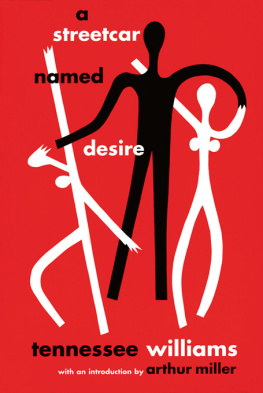
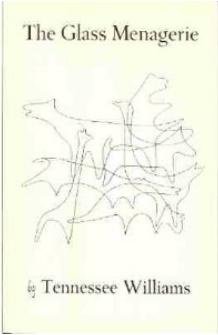

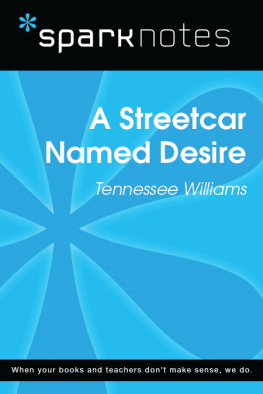
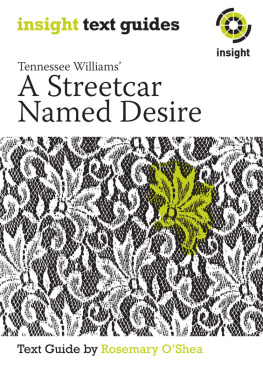
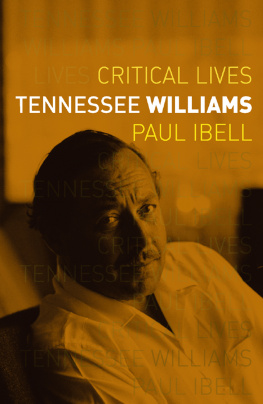
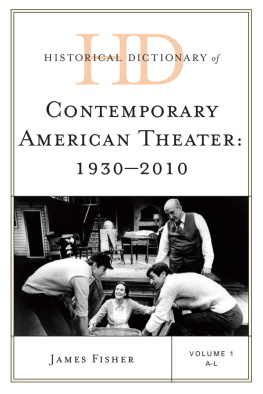

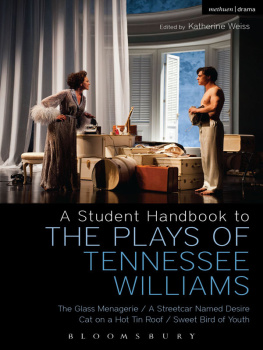
 BY TENNESSEE WILLIAMS PLAYS Baby Doll & Tiger Tail Camino Real Candles to the Sun Cat on a Hot Tin Roof Clothes for a Summer Hotel Fugitive Kind The Glass Menagerie A House Not Meant to Stand A Lovely Sunday for Creve Coeur Mister Paradise and Other One Act Plays Not About Nightingales The Notebook of Trigorin Something Cloudy, Something Clear Spring Storm Stairs to the Roof Stopped Rocking and Other Screen Plays A Streetcar Named Desire Sweet Bird of Youth 27 Wagons Full of Cotton and Other Plays The Traveling Companion and Other Plays The Two-Character Play Vieux Carr THE THEATRE OF TENNESSEE WILLIAMS, VOLUME I Battle of Angels, A Streetcar Named Desire, The Glass Menagerie THE THEATRE OF TENNESSEE WILLIAMS, VOLUME II The Eccentricities of a Nightingale, Summer and Smoke, The Rose Tattoo, Camino Real THE THEATRE OF TENNESSEE WILLIAMS, VOLUME III Cat on a Hot Tin Roof, Orpheus Descending, Suddenly Last Summer THE THEATRE OF TENNESSEE WILLIAMS, VOLUME IV Sweet Bird of Youth, Period of Adjustment, The Night of the Iguana THE THEATRE OF TENNESSEE WILLIAMS, VOLUME V The Milk Train Doesnt Stop Here Anymore, Kingdom of Earth (The Seven Descents of Myrtle), Small Craft Warnings, The Two-Character Play THE THEATRE OF TENNESSEE WILLIAMS, VOLUME VI 27 Wagons Full of Cotton and Other Short Plays THE THEATRE OF TENNESSEE WILLIAMS, VOLUME VII In the Bar of a Tokyo Hotel and Other Plays THE THEATRE OF TENNESSEE WILLIAMS, VOLUME VIII Vieux Carr, A Lovely Sunday for Creve Coeur, Clothes for a Summer Hotel, The Red Devil Battery Sign POETRY Collected Poems In the Winter of Cities PROSE Collected Stories Hard Candy and Other Stories One Arm and Other Stories Memoirs The Roman Spring of Mrs. Stone The Selected Letters of Tennessee Williams, Volume I The Selected Letters of Tennessee Williams, Volume II Where I Live: Selected Essays TENNESSEE WILLIAMS A STREETCAR NAMED DESIRE INTRODUCTION BY ARTHUR MILLER
BY TENNESSEE WILLIAMS PLAYS Baby Doll & Tiger Tail Camino Real Candles to the Sun Cat on a Hot Tin Roof Clothes for a Summer Hotel Fugitive Kind The Glass Menagerie A House Not Meant to Stand A Lovely Sunday for Creve Coeur Mister Paradise and Other One Act Plays Not About Nightingales The Notebook of Trigorin Something Cloudy, Something Clear Spring Storm Stairs to the Roof Stopped Rocking and Other Screen Plays A Streetcar Named Desire Sweet Bird of Youth 27 Wagons Full of Cotton and Other Plays The Traveling Companion and Other Plays The Two-Character Play Vieux Carr THE THEATRE OF TENNESSEE WILLIAMS, VOLUME I Battle of Angels, A Streetcar Named Desire, The Glass Menagerie THE THEATRE OF TENNESSEE WILLIAMS, VOLUME II The Eccentricities of a Nightingale, Summer and Smoke, The Rose Tattoo, Camino Real THE THEATRE OF TENNESSEE WILLIAMS, VOLUME III Cat on a Hot Tin Roof, Orpheus Descending, Suddenly Last Summer THE THEATRE OF TENNESSEE WILLIAMS, VOLUME IV Sweet Bird of Youth, Period of Adjustment, The Night of the Iguana THE THEATRE OF TENNESSEE WILLIAMS, VOLUME V The Milk Train Doesnt Stop Here Anymore, Kingdom of Earth (The Seven Descents of Myrtle), Small Craft Warnings, The Two-Character Play THE THEATRE OF TENNESSEE WILLIAMS, VOLUME VI 27 Wagons Full of Cotton and Other Short Plays THE THEATRE OF TENNESSEE WILLIAMS, VOLUME VII In the Bar of a Tokyo Hotel and Other Plays THE THEATRE OF TENNESSEE WILLIAMS, VOLUME VIII Vieux Carr, A Lovely Sunday for Creve Coeur, Clothes for a Summer Hotel, The Red Devil Battery Sign POETRY Collected Poems In the Winter of Cities PROSE Collected Stories Hard Candy and Other Stories One Arm and Other Stories Memoirs The Roman Spring of Mrs. Stone The Selected Letters of Tennessee Williams, Volume I The Selected Letters of Tennessee Williams, Volume II Where I Live: Selected Essays TENNESSEE WILLIAMS A STREETCAR NAMED DESIRE INTRODUCTION BY ARTHUR MILLER  A NEW DIRECTIONS BOOK Copyright 1947 by The University of the South Renewed 1957 by The University of the South Introduction, Regarding Streetcar Copyright 2004 by Arthur Miller The World I Live In Copyright 1957 by The University of the South Copyright 2004 by New Directions Publishing Corporation All rights reserved. Except for brief passages quoted in a newspaper, magazine, radio, television, or website review, no part of this book may be reproduced in any form or by any means, electronic or mechanical, including photocopying and recording, or by any information storage and retrieval system without permission in writing from the Publisher. CAUTION: Professionals and amateurs are hereby warned that A Streetcar Named Desire, being fully protected under the copyright laws of the United States of America, the British Commonwealth including the Dominion of Canada, all countries of the Berne Convention, and of all other countries with which the United States has reciprocal copyright relations, is subject to royalty. All rights, including professional, amateur, motion picture, recitation, lecturing, public reading, radio and television broadcasting, video or sound recording, all other forms of mechanical or electronic reproduction, such as CD-ROM, CD-I, information storage and retrieval systems and photocopying, and the rights of translation into foreign languages, are expressly reserved. Particular emphasis is laid on the question of readings, permission for which must be secured from the agent for The University of the South, Casarotto Ramsay & Associates Limited, National House, 60-66 Wardour St., London WIV 3ND, England.
A NEW DIRECTIONS BOOK Copyright 1947 by The University of the South Renewed 1957 by The University of the South Introduction, Regarding Streetcar Copyright 2004 by Arthur Miller The World I Live In Copyright 1957 by The University of the South Copyright 2004 by New Directions Publishing Corporation All rights reserved. Except for brief passages quoted in a newspaper, magazine, radio, television, or website review, no part of this book may be reproduced in any form or by any means, electronic or mechanical, including photocopying and recording, or by any information storage and retrieval system without permission in writing from the Publisher. CAUTION: Professionals and amateurs are hereby warned that A Streetcar Named Desire, being fully protected under the copyright laws of the United States of America, the British Commonwealth including the Dominion of Canada, all countries of the Berne Convention, and of all other countries with which the United States has reciprocal copyright relations, is subject to royalty. All rights, including professional, amateur, motion picture, recitation, lecturing, public reading, radio and television broadcasting, video or sound recording, all other forms of mechanical or electronic reproduction, such as CD-ROM, CD-I, information storage and retrieval systems and photocopying, and the rights of translation into foreign languages, are expressly reserved. Particular emphasis is laid on the question of readings, permission for which must be secured from the agent for The University of the South, Casarotto Ramsay & Associates Limited, National House, 60-66 Wardour St., London WIV 3ND, England.